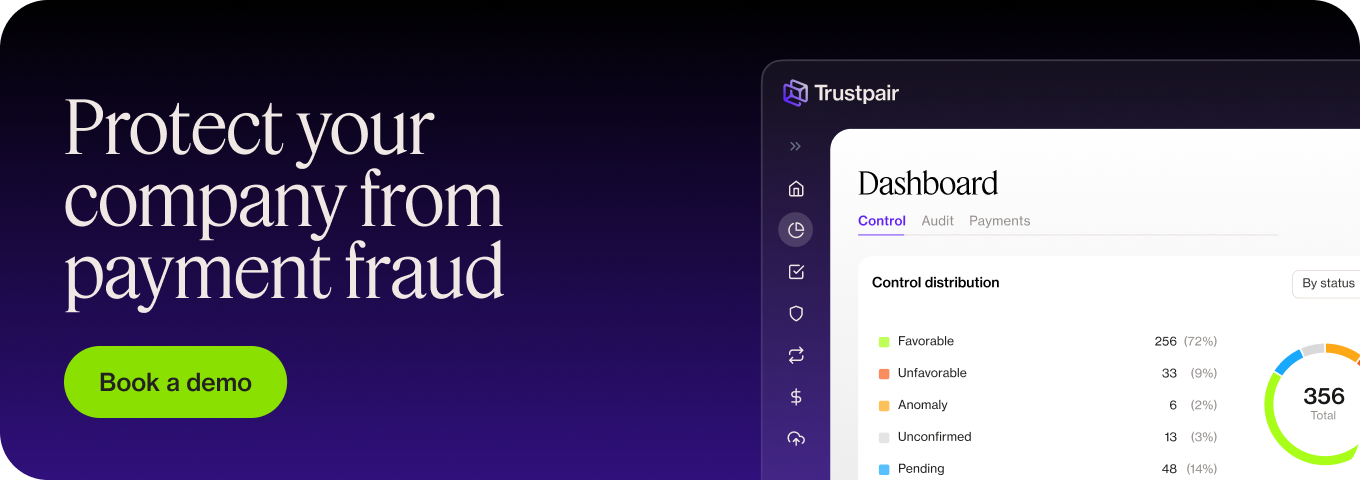Instant ACH transfers let money move through the ACH Network in real time instead of the usual 1–3 business days. They offer a faster way for businesses to send and receive payments while keeping ACH’s low fees and reliability.
This guide explains what instant ACH is, how it works, and when to use it compared to standard or same-day ACH transfers. It also covers the risks and controls finance teams should consider.
Key Takeaways:
- Instant ACH transfers enable real-time fund movement, offering a faster alternative to standard ACH processing times.
- These transfers rely on third-party providers rather than the ACH Network alone, which affects availability and transaction limits.
- Instant ACH increases operational and fraud risks because payments settle immediately and are often irreversible.
- Strong internal controls and accurate bank account validation are essential to reduce errors and protect against fraudulent transfers.
What is an ACH transfer?
ACH transfers are at the forefront of the finance automation revolution in the US. The ACH Network is governed by Nacha, a nonprofit association that sets the rules and standards for ACH transactions. While Nacha doesn’t process payments directly, all participants in the network must comply with the Nacha Operating Rules and Guidelines, ensuring consistency, security, and reliability.
ACH transfers allow individuals and businesses to send money automatically on a scheduled basis, like a direct debit. They’re aggregated from the various banks and sent in one go, which means that there can be a delay in the payment, it’s not immediate like a wire transfer.
ACH transfers can be categorized into direct deposits (the money received) and direct payments (the money paid out). A company’s payroll is likely to make use of this technology to batch salary payments each month. This way, the accounts information can be completed early on, payments can be approved and the rest can be automated on a large scale.
How long does it typically take for ACH transfers to be processed?
Budget for approximately three working days for an online banking ACH transfer to take place. But it could be as little as the same day, or as much as a few months if the file data is incorrect. That’s largely because ACH transfers happen in batches.
Here’s a breakdown of the timeline for ACH payments:
- Day 1: You submit the payment and an ACH file is submitted to your bank, which then processes the file on their end and submits this to the ACH network
- Day 2: The network makes the file available to the customer’s bank, where the funds are debited into an originating depository financial institution (ODFI)
- Day 3: The funds are collected by your bank, the receiving depository financial institution (RDFI), which is responsible for posting the funds into your account and confirming the accuracy
The terms ODFI and RDFI can refer to any of the banks that support ACH payments (pretty much any bank in the US), and have different responsibilities. ODFIs must ensure the security of the transaction request file, and ensure that ACH returns are kept low (ie. if a customer’s account doesn’t have the required funds to make the payment). Alternatively, RDFIs are responsible for simply receiving the money and posting it into the receiver’s account in a timely manner.
Confusingly, all ODFIs must also take responsibility for RDFIs, but not all receiving banks have to perform originating duties.
What does the term “same-day ACH transfer” refer to?
If you can’t afford to wait for three days to send or receive money, you can still make use of the ACH network to digitize the financial and payment process. But there are some limitations.
Same-day ACH refers to debit and credits, thanks to two additional clearing windows within the network. This is the responsibility of the ODFIs since RDFIs receive payments on the same day anyway.
The two new clearing windows are detailed as follows:
- ODFI submission by 10:30 am (ET) to settle at 1 pm
- ODFI submission by 2:45 pm (ET) to settle at 5 pm
Same-day ACH transferring is useful in several business scenarios. Firstly, for same-day payrolls where businesses owe wages or have emergency payment needs. Secondly, in the case of expedited bill pay to suppliers or merchants, where the originating company could receive discounted billing for “early payments”.
What is an immediate ACH transfer?
Some third-party providers can facilitate instant ACH transfers. This means that the money is made available before they’re even received by the RDFI. But the ACH network alone doesn’t provide this service.
The most common use case for immediate ACH transfers is peer-to-peer transfers like – Paypal or Venmo. The third-party covers the amount, and the funds transfer is finalized later in a formal ACH process. This could be particularly useful if you need to transfer money at the last minute.
Of course, instantaneous transfers are significantly more limited around the transaction value, which makes them better suited for personal use rather than business use.
What is the difference between ACH and instant payment?
From a business perspective, it’s good to weigh up the pros and cons of each payment type so that you can run as efficiently as possible. So, here are the main differences between ACH and instant payments:
| ACH payment | Instant payment |
| Takes a few days to settle | Settled immediately |
| Low fees ($0.25 per transfer) | Costly to achieve (approx $25 per transfer) |
| Best for US-to-US accounts | Best for US to international accounts (or vice versa) |
| Suits recurring payments | Suits one-off payments |
| Secured through a network and Federal Reserve monitoring | Less secure as international standards vary |
What are the challenges of instant ACH?
While an instant ACH transfer offers speed and convenience, it also comes with key challenges businesses should consider.
- Limited Reversibility
Unlike traditional ACH transfers or same day ACH transfers, most instant ACH payments are final. Once the funds reach the receiver’s account, they can’t be reversed – making payment processing errors or fraud harder to correct.
- Not Universally Supported
Not all financial institutions offer instant ACH transfer online capabilities. Many still rely on standard ACH or same day ACH, which limits compatibility across payment platforms and complicates funds transfer between certain bank accounts.
- Transaction Limits
Most instant ACH providers impose caps on ACH transactions, making it unsuitable for high-value or international transactions. This can restrict usage in enterprise-level bill payments, direct deposits, or bulk recurring payments. Transactions have a limit of $ 1 million, and not all US banks participate.
- Pressure on Internal Controls
The speed of immediate ACH transfers puts pressure on internal teams to validate payment information instantly. Without strong controls, there’s a higher risk of sending funds to the wrong account number, impacting financial health and disrupting cash flow. Solutions like Trustpair’s account validation automate bank detail verification, reducing manual errors and securing payments before execution.
What are the fraud risks for instant payments?
Unfortunately, since instant payments are not subject to the same rigorous security measures of the ACH network, they bring greater challenges for finance departments, especially in the risk of fraud.
When you opt for the ACH, since all payments are routed through the clearing house, they can be reversed if the details aren’t correct. In fact, the ACH has its own file system to ensure that requests are rejected if the account holder, routing number, or checking account data doesn’t match.
Moreover, the entire ACH transaction network is monitored by the Federal Reserve. This is likely to deter money launderers or those financing terrorists, or committing other financial crimes like fraud.
But instant payments aren’t afforded the same protections, meaning they can leave your accounts payable process exposed to fraud. What’s more, since they work in real-time, instant payments put pressure on the internal authentication process of your company. If your verification is not rigorous enough, fraudsters could target the business and essentially, steal your hard-earned money.
But that’s why Trustpair exists. We authenticate the details of your third parties so that you can verify they are who they say they are. Since the platform works in real-time, it will block any pending payments to merchants and suppliers if the invoice information doesn’t match the banking databases. Working on a domestic and international level, your finance team can focus on getting the job done, instead of worrying about the threat of fraud.
To avoid transfer fraud, Trustpair continuously audits supplier data to detect suspicious activity and control payments before the money is out of your hands. Contact an expert to learn more!


